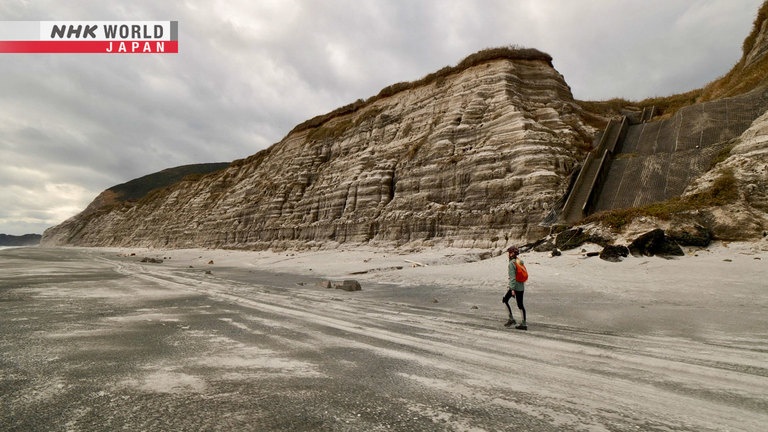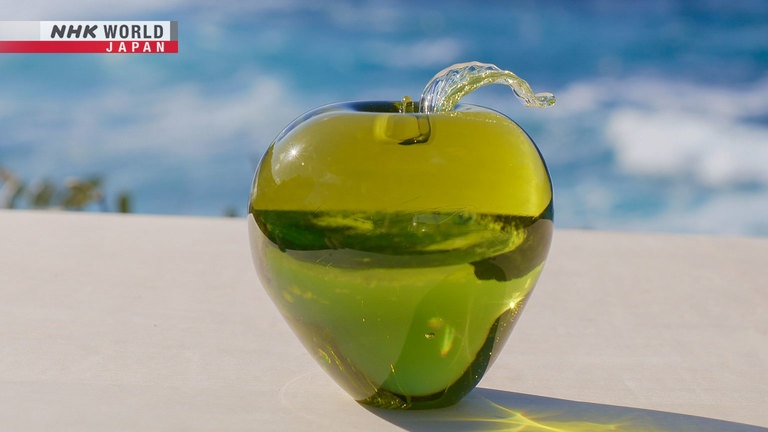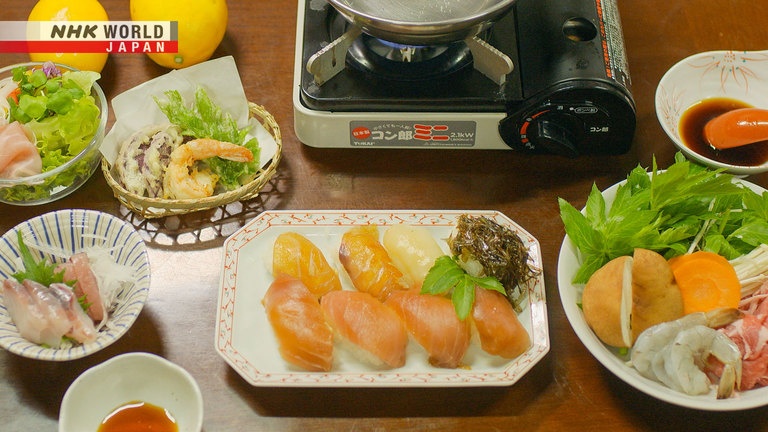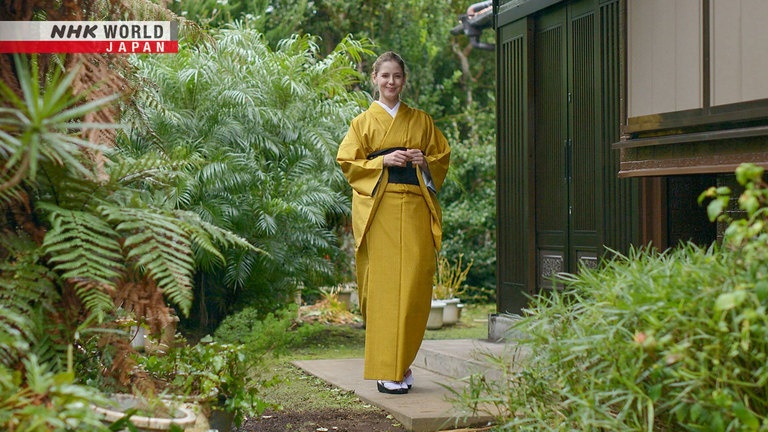Tokyo's Islands Niijima and Hachijojima
A cycle tour of two remote islands that lie within Tokyo's city limits. On Niijima, we see homes built with a hard volcanic rock called Koga stone, which is also used to make glass art. Locals still carefully tend the graves of exiles banished here during samurai times, who brought education to the island. On Hachijojima, an ancient textile tradition creates complex, subtle patterns using only three colors of plant-dyed yarn. We also sample island food and learn about a much loved local newspaper.




Transcript
The best way to discover little-known sights and make even familiar places feel brand new, is to go exploring by bicycle.
Did you know that inside Tokyo's city limits is an entire chain of volcanic islands?
It's hard to imagine scenery more unlike the skyscrapers and bustling streets of Japan's capital.
Our cyclist today is Janni Olsson.
Whatever the road throws up, Janni's the type who laughs and plows on regardless.
She'll be meeting island artists who use unique local materials in their work.
We use only three colors of yarn,
but even so the possibilities are infinite.
And she'll discover some of the long and surprisingly complex history of these tiny, remote islands.
For 90 years, our paper was a record of island life.
Small islands, but lots to see!
Let's go!
The ocean's beautiful. Look at that color!
Our cyclist is on a small propellor plane headed for her first stop - Niijima Island.
Janni, from Sweden, has been living in Japan for eight years.
She loves the outdoors, and often goes bikepacking.
I have never ridden a bike around islands before so this is going to be super fun.
I can't wait to see what sights I will see here, and what people I will meet.
I will see you guys later.
From the city, it's a 40-minute flight south to the island.
This airport statue hints at what brings most visitors to Niijima.
Okay, let's get this journey started.
The wind is cold but the weather is great.
January is the chilliest month here.
Today it's a bracing eight degrees Celsius.
We're still in Tokyo, but this water does not look quite like the water you see in Tokyo.
Waa, that's magical.
Just ten minutes from the airport, and Janni has found a long, white sand beach.
What is this?
Let's check it out.
That turquoise water is still really unbelievable.
Look at this!
Habushiura Beach is one of Japan's top surfing spots, and often hosts international competitions.
Look at that guys.
I've never seen anything like this before.
These 250-meter-high cliffs were formed from deposits of volcanic ash.
Wind eroding the rocks created the sandy beach below.
Janni heads back inland.
We have the island village over here.
About 2,500 people live on Niijima.
Ah we have all these kind of...
There's a lot of stone walls inside this village.
Look, here we have all these stone houses again.
Janni has arranged to meet up with a guide to the island.
Ah, there she is!
Hello! Can I ask you something?
You can speak Japanese?
Oh you speak English!
- A little.
- A little bit.
It's fine to talk in Japanese too.
Sugai Kiyo was born here on Niijima, 80 years ago.
She taught English at the local junior high school.
I've been seeing this kind of home everywhere.
They're made with a local rock called Koga stone.
This stone, formed from solidified lava, is very durable.
Isn't it cold? Even the roof is stone.
No. It's warm in winter, cool in summer.
That's why everyone builds with Koga stone.
Another name for it is karuishi, or light stone.
Wow! It is light!
It's really easy to work with.
When I was in junior high school,
we used it at lot in art class.
The first half of class was spent carrying
stone from the mountain in baskets.
It was really good for making sculptures.
In the 1970s, Niijima's main industry was quarrying Koga stone, which was in demand throughout Japan.
It was one of the island's few resources, so they made use of it in every way possible.
Sugai decides to show Janni a site very dear to these islanders' hearts.
Hello!
Good morning!
- She's come all the way from Sweden.
- You're very pretty.
They're in the island cemetery.
Where does all this white sand come from?
The beach at Habushiura.
It looks so beautiful around the graves.
I'm sure it makes them happy.
One corner of the cemetery is treated by the islanders with special respect.
This is the exiles' graveyard.
During the samurai era, criminals could be sentenced to banishment on Niijima.
Among the 1,300 or so exiled here were many intellectuals convicted of political crimes.
The islanders had huge respect for the exiles,
who taught them a lot, including medicine.
Everybody on Niijima knows this history.
Ah, Fumi-chan, you've been cleaning the graves?
- Your friend?
- Yes, she's always here, keeping it neat.
- So you look after the graves together?
- Yes.
Actually there are about 100 of us.
Everyone takes a turn.
- A hundred of you!
- All us old folks.
Everyday life on this island still very much revolves around mutual cooperation.
So on a tiny island like this,
you all help each other in everything?
Yes, the spirit of cooperation is very strong.
Helping each other is the only way to survive.
All you need in life is health,
a little money and a few friends.
That's very true.
Leaving Sugai, Janni goes looking for the mountain of Koga stone.
This is getting hard.
Ah, look at this!
Maybe this is where they took all the stones in the past?
She's found what must be an old quarry site.
What is this?
Ah, let's see what we have here.
Is this glass? What is that?
What!?
Yes, that's definitely glass.
It's like green, really thick green glass, so...
This place is a museum, showcasing artworks created using glass made here on Niijima.
- Hello!
- Hello! Pleased to meet you.
You're welcome.
- Is all this glass made on the island?
- That's right.
We melt Koga stone to produce this green colored glass.
- You can make glass from volcanic rock?
- Yes.
Microscopic amounts of iron make it green.
The iron melts together with other natural elements
to give this nice olive green shade.
This apple paperweight is one of Noda's creations.
- Look through it.
- I see the sky!
You get very pretty reflections.
It's so clear it reflects any scene beautifully.
This is our workshop.
And this is my husband, Osamu.
Hello!
Noda Osamu was born here on Niijima.
He and Yumiko met when they were both studying glass art at university in Tokyo.
After further studies in the US, they returned to Niijima and began creating art together.
Niijima glass is valued for its durability, but it's difficult to work with as it starts hardening very quickly after it's pulled from the furnace.
He makes this really nice round shape and then, I guess in half a second he went and made this form.
Wow!
Niijima glass hardens the moment it cools.
It resists the heat well,
so you can easily make sharp angles like this.
Osamu is always seeking to make use of the unique characteristics of this glass.
This design is inspired by the sharp projections of a Turban Shell.
He says it took ten years practice before he could achieve the results he wanted in glass made from Koga stone.
This kind of volcanic rock is especially hard to work with.
But it's interesting to work around the limits,
and find new ways to use it.
Niijima never had a glass making tradition before Noda started it 35 years ago.
Today, the island is one of Japan's foremost centers for glass art.
Janni has one last question for Yumiko.
What kind of person is her husband?
He's extremely tenacious. That's what
allowed him to create that turban shell glass.
I grew up on this island,
so I guess I just work to a slower rhythm.
He refuses to compromise.
- I guess I am pretty stubborn.
- That's for sure.
She should know...
This whole island is just like a kind of picture book.
Wherever you look, you have these amazing views.
Today, Janni has come to Hachijojima.
This island, home to just over 7,000 people, is located about 300 kilometers south of Tokyo city.
Look at that view, guys.
We do have some suspicious clouds up there, but, let's go!
So I have actually been to Hachijojima before in the past.
The only thing is that when I came here last time, I only went out to sea.
I did some fishing, and then I ate some dishes. So I'm back.
OK, let's go!
Windy, but let's go to the ocean.
The sun! The ocean!
Look at that.
That is not Niijima.
What is that?
The neighboring small island of Hachijokojima once had a population of 500, but it's now uninhabited.
This is definitely a volcano.
This kind of looks like magma. Like old ones.
This rugged lava coastline tells the story of the ancient volcanoes that gave birth to these islands.
People have been living on Hachijojima for thousands of years, and the island developed its own unique culture.
Look at this.
What are all these old stones here?
Looks like an egg pack with a lot of eggs lined up here.
Known as tamaishigaki, this style of wall is a feature of Hachijojima.
These stones, made round by the action of the waves, are found everywhere along the island's coastline.
In the old days, only people of high status surrounded their homes with walls like this.
What's this?
It says Kihachijo...
There's some kind of sound coming from...
Let's see what they're making.
Wow! Look at that!
Janni has found a textile workshop.
- Hello! Welcome.
- Hello.
- Can I ask a few questions?
- Sure.
I heard a strange banging
and wondered what you're making in here.
Kihachijo textile, unique to this island.
It takes a lot of strength to weave.
Up here you can feel the floor shaking.
Wow, it's really vibrating.
That's what makes it so tough,
your grandchildren will still be using it.
The history of Kihachijo silk goes back over 1,000 years.
Garments made of this material were luxury items, supplied to the Shoguns in Edo.
Yamashita Fumiko, the workshop's 4th generation owner, has been working in textiles since she was 18.
We use three colors of yarn: yellow, black,
and this dark red.
Looks like it's shining like gold or something like that, like an old metal.
It's beautiful.
All three pigments are made with plants native to Hachijojima.
This plant, called kobunagusa, produces the yellow dye.
Only three colors, but colors with a subtle complexity.
In chemical dyes, only yellow pigments are
used to produce the yellow color.
But yellow from plant dyes also includes
green, gray and other color pigments.
The undertones make it flattering to the skin.
Beautiful!
This green, and a little...
It looks green, but we don't use green yarn.
By weaving the three colors of yarn together in various combinations, the artisan creates the effect of many different hues.
Yellow for the warp and gray for the weft.
Woven together they look green.
The result is unique - no two patterns are ever alike.
This means that Yamashita will always be able to create exactly the designs that people want to wear, so this is a tradition with a future.
I enjoy thinking about how many more patterns I can create.
Using only three colors doesn't really limit us.
Half the fun is figuring out how to get the effects
I want with just three colors of yarn.
When Yamashita retires, her son Yu will take over the workshop.
My parents are getting older,
so I need to work with them.
I still have so much to learn.
I have three boys. When I asked them to try weaving,
they were all able to do it right away.
And what's more, they all did it
with exactly the same rhythm as I do.
That's very unusual.
I guess it must be in the genes.
Special treatment for the visitor!
Janni is invited to try on a kimono.
It's so beautiful.
Of all the kimonos I've worn,
this is definitely my favorite.
Each one unique, a Kihachijo kimono expresses the creativity of its weaver.
You guys, know what? I don't like hills.
Does anyone like hills here? I don't.
Look at that view!
Hello sun.
It'll soon be dark, so Janni must hurry to reach her lodgings for the night.
I think this is it.
Ah, we're here.
It's an old-style country guesthouse.
This is the place I want to show you, guys.
Hello!
It's been so long.
Do you remember me?
Welcome back!
A few years ago I ate flying fish here.
And now I'm back!
- So pleased to meet you again.
- Me too!
Fukuda Eiko, now 83, has been running this guesthouse for 56 years.
Janni lends a hand with the sushi, something Hachijojima is famous for.
Put two of those here.
- What's this, nori?
- Iwanori.
It's a way of eating nori you only see on Hachijojima.
Get some ashitaba leaves from over there.
Next, they'll make tempura with ashitaba.
They love to eat this herb on Hachijojima.
Sounds delicious.
But I don't know how to make tempura.
What do I do?
Janni isn't used to deep frying, since it wasn't the custom to do this at home in her native Sweden.
- Let the oil drain first!
- Oh, sorry!
I don't know how to cook. Help me!
Can you drink alcohol? How old are you?
I'm 37. Old enough?
Hachijojima is famous for the white spirit called shochu.
They begin with the sushi they just made.
This is the special island sushi topped with nori seaweed.
It's delicious.
Almost like a vegetable.
You don't really have this heavy smell from the ocean, anything like that.
It's really light and it's really fresh.
- Cheers!
- Cheers!
Born on Hachijojima, Fukuda has never considered living anywhere else.
This is the best!
Do you ever think of leaving the island?
No, it's perfect here. It's the only place for me.
No convenience stores, but we have nature,
mountains and the ocean.
That's all I need.
- Well, there's this too.
- Right!
On this final morning, the sky is overcast and unfortunately the weather doesn't look great for cycling.
So it's raining right now, and I know a lot of people riding the bike don't like the rain.
The thing is like, in Sweden we have a motto that is "there's no bad weather, there's only bad clothes."
If you don't want to go out riding your bike or can't be assed because it's raining, you're never going to get out there and do anything,
because you're just going to wait for that perfect opportunity.
Good morning!
Beautiful weather.
I told you!
It's stopped raining.
There's almost no wind, so you just have to stay positive.
After an uphill comes a downhill; after the rain comes the sun.
So, let's go to the ocean.
That's a great view.
After circling the island, Janni has now come to its main town.
Good morning!
It should be around here.
Let's see. Wait...
Yep!
This is a local newspaper office.
- Hello!
- Hello.
I was told this is a newspaper office,
but it doesn't feel like it.
Yes. Just a moment.
I'll call Mari.
Karita Yoshiyuki and his wife Mari are newspaper reporters.
There's just the two of us here now.
The Nankai Times was started in 1931.
Mari's grandfather worked on the paper, and it became a family tradition.
It's a stamp?
It says Nakai Times - News Flash.
- Did you use them a lot?
- Yes.
First Issue Mission Statement: "Out of our love for these islands...
We will never stand silent in the face of injustice or those who aim for war."
The Nankai Times was published twice a month as a four-page tabloid, selling about 2,000 copies.
The paper covered items of local interest, from politics and economics to events on Hachijojima.
Back issues record aspects of island life that have now vanished.
We used to have bull sumo on the island.
It was a custom for hundreds of years.
I talked to this man, the last bull sumo organizer.
He was losing money and nobody wanted to take over.
His father loved his bulls so much he even slept with them.
The son did too. I heard he gave them everything,
even feeding them miso soup.
The thoughts and feelings of past islanders live on in these articles.
These are thank-you notes from the bereaved
to people who came to funerals and wakes.
This family had just lost their mother.
"She was always laughing and telling us
'You have to enjoy yourself while you're alive'."
Telling people what their mother was like.
Our readers always enjoyed this section.
We all like finding out about other people's lives.
This was our last issue, announcing
that we were suspending regular publication.
June, 2020.
The Nankai Times had lost so much advertising in the pandemic that it was no longer financially viable.
Yoshiyuki and Mari are now searching for ways to use their 90-year archive of island life.
One project is this commemorative issue requested by the town, tracing Hachijojima's 100-year history of cultivating ornamental plants.
They also interviewed the latest generation of young farmers, adding new memories to the old records.
Hello!
Hello!
Thanks for letting me interview you.
How did it feel to see yourself in the paper?
My children were thrilled.
I was thinking about them as I wrote it.
This is an island tradition.
I hope they'll follow in my footsteps.
What did the Nankai Times mean for the town?
I'd read it every day at work when I took a break.
It was a sad day when they stopped.
- Would you like them to start up again?
- Oh, absolutely!
A newspaper keeps people connected
with everything that goes on in society.
It's a record of the island we can always refer to.
That helps us stay on the right track
and hopefully do things better in future.
Janni's final goal is on the far side of the island's highest peak, Mount Hachijo-Fuji.
Ah, yeah, look at that view.
The road takes her around the side of the mountain.
I'm getting closer.
Ah, I think we're here.
There's that little island over there, and then we have all of Hachijojima over here.
This is it, the end of Janni's trip.
Yeah, so even in this really limited space there have been so many things to see, and so many people to talk with about their different culture that is quite different from over there, from the mainland.
I think the kimono in Hachijojima was amazing.
So it was fascinating seeing that sometimes having a lot of options isn't the best thing, actually.
But working with what you have and staying positive and just working with that, and then enjoying what you have to create something good was really inspiring to see.
It's especially because it is a really small island that people know each other so well.
I think at least if I lived here and I died here, I would be really happy that it feels like people would remember me for who I was, not kind of the big things.
Yeah, really fascinating travel.
It was a super small island, but there's so many stories to be told here.
Life on an island may seem to have limited options, but it also offers the endless freedom to explore your potential.